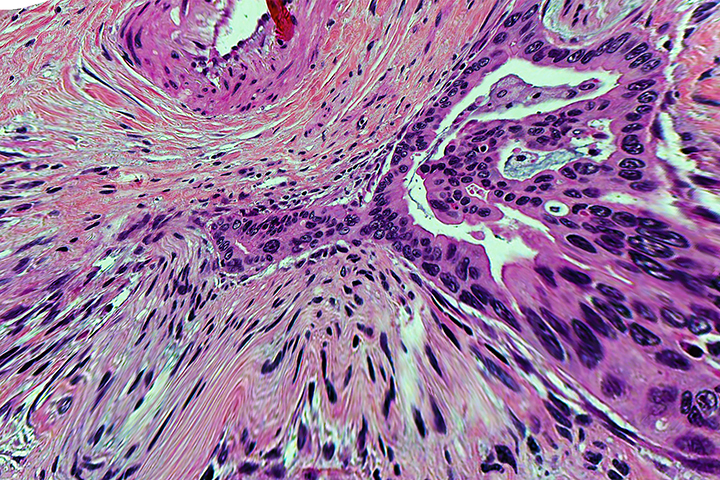What Is Pancreatic Cancer?

Konstantin Bräutigam, SNSF Scientific Photo Competition; Flickr
Pancreatic cancer is a disease in which abnormal cells in the pancreas begin to grow and multiply out of control.
Defects or unusual changes, known as mutations, in pancreatic cells cause these unhealthy cells to grow. These abnormal cells may clump together into a tumor. The tumor may be harmless—or benign—or the tumor may be cancerous, called malignant.
What Does a Healthy Pancreas Normally Do?
A fish-shaped organ roughly the size of your hand, the pancreas is a part of two body systems—your digestive system and your endocrine system, which is made up of organs that release hormones. The pancreas aids in digestion by helping the body to break down food. Its role in the endocrine system is to make the hormones insulin and glucagon. These two hormones help control your blood sugar levels. Insulin causes the body to store sugar in its cells, while glucagon stimulates the liver and muscles to release and break down stored glucose.
Pancreatic cancers are generally classified into two basic categories, exocrine and endocrine.
Exocrine (Nonendocrine) Cancer
Most pancreatic cancers fall into this category. Exocrine cells release enzymes that aid your digestive system in breaking down carbohydrates, fats, proteins, and acids in the first part of the small intestine, called the duodenum.
Pancreatic Adenocarcinoma
Pancreatic adenocarcinoma is, by far, the most common type of pancreatic exocrine cancer, accounting for about 95 percent of all cases. In most cases, these cancers form inside the lining of tubes in the pancreas, known as ducts, that are responsible for releasing hormones. For this reason, pancreatic adenocarcinoma has earned another name: ductal carcinoma.
In less common cases, cancer may form in special cells that produce enzymes, which the pancreas uses to speed up various functions it carries out. Pancreatic cancer that starts in these cells is called acinar cell carcinoma.
Adenosquamous Carcinoma
Considered rare, this kind of cancer accounts for 1 to 4 percent of all nonendocrine cancers. These are faster-growing tumors. Sometimes these tumors are associated with a BRCA mutation. As the name suggests, the tumors found in this cancer type have features of both squamous cell carcinoma and ductal carcinoma.
Squamous Cell Carcinoma of the Pancreas
An extremely rare exocrine cancer, squamous cell carcinoma is distinguished from other cancers by the type of cancer cells involved in it. Four types of cells make up a healthy pancreas. These are alpha, beta, delta, and C cells. Squamous cells are very rare, and usually they are only seen when cancer is present.
Colloid Carcinoma
Also rare are colloid carcinomas, which make up 1 to 3 percent of all endocrine pancreatic cancers. However, the good news is that this cancer usually produces a benign cyst. Known as intraductal papillary mucinous neoplasm (IPMN), malignant cells caused by this kind of cancer tend to spread less because they are often in a thick, slimy protein. Because the bad cells are less likely to spread, this cancer is easier to treat than other pancreatic cancers.
Other Nonendocrine Cancers
In addition to adenosquamous carcinomas and squamous cell carcinomas, examples of less common kinds of exocrine cancers include the following:
- Signet ring cell carcinomas
- Undifferentiated carcinomas
- Undifferentiated carcinomas with giant cells
Neuroendocrine Pancreatic Cancer
Pancreatic neuroendocrine tumors (PNETs), also known as islet cell tumors, are another type of pancreatic cancer. These cancers form in the endocrine cells that produce glucagon and insulin. While less common, people who have PNETs tend to have better survival rates than people who have exocrine cancer.
Ampullary Cancer
Ampullary cancer (carcinoma of the ampulla of Vater) accounts for less than 1 percent of all cancers of the digestive system. This form of cancer is quite rare. This cancer is named for the area where it starts—at the site where the pancreatic duct and bile duct join to empty their contents into the small intestine.
Although it is not considered pancreatic cancer, it is treated like pancreatic cancer. And like pancreatic cancers, it can be tricky to catch as it tends to mimic a large variety of other conditions because the main noticeable sign is jaundice or yellowing of the skin.






